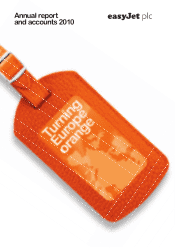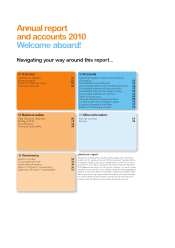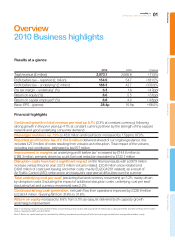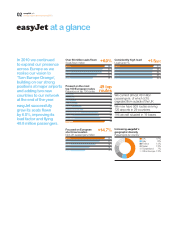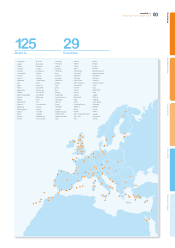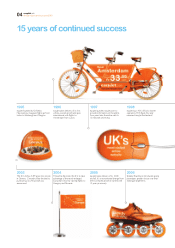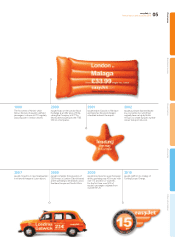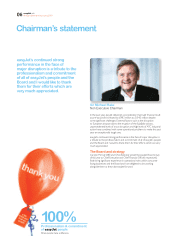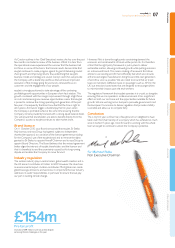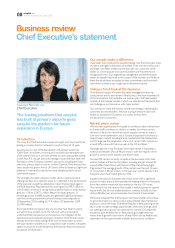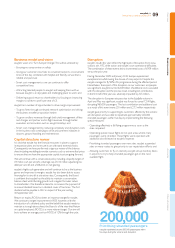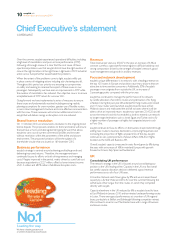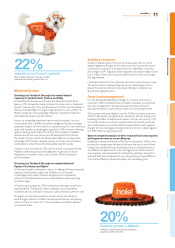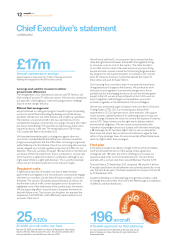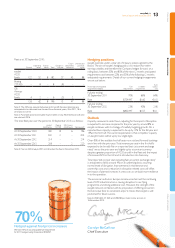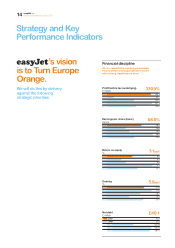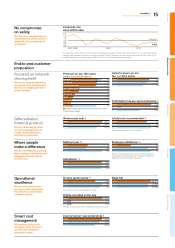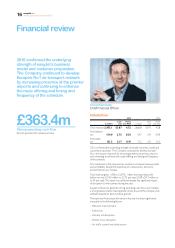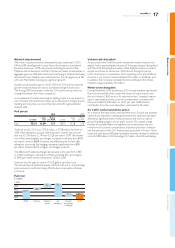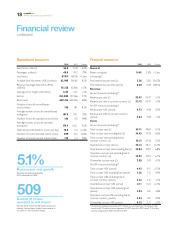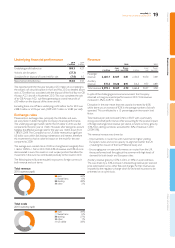EasyJet 2010 Annual Report Download - page 11
Download and view the complete annual report
Please find page 11 of the 2010 EasyJet annual report below. You can navigate through the pages in the report by either clicking on the pages listed below, or by using the keyword search tool below to find specific information within the annual report.
Business model and vision
easyJet’s vision is to ‘Turn Europe Orange’. This will be achieved by:
– Ensuring no compromise on safety;
– Giving our customers low fares to convenient airports at convenient
times of the day combined with helpful and friendly service that is
reliable and punctual;
– Smart cost management so we can continue to offer
competitivefares;
– Attracting talented people to easyJet and keeping them with us
because easyJet is an enjoyable and challenging place to work; and
– Delivering a good return to shareholders by focusing on improving
margins to achieve a prot per seat of £5.
easyJet has a number of opportunities to drive margin improvement:
– To grow fares through continued network optimisation and driving
the business traveller proposition harder;
– To grow ancillary revenues through both yield management of fees
and charges and partner and in-ight revenues through better
execution and innovation such as easyJet Holidays; and
– Smart cost management by reducing complexity and disruption costs
in the business and continuing to drive procurement initiatives in
airports, ground handling and maintenance.
Capital structure review
It is vital that easyJet has the nancial resources in place to support
itsexpansion plans and to ensure it can withstand external shocks.
Consequently, we have performed a rigorous review of the balance
sheet including modelling downside scenarios such as extreme fuel prices
to ensure that we have the appropriate capital structure going forward.
We will continue with a conservative policy including a liquidity target of
£4 million cash per aircraft, a leverage cap of £10 million adjusted gross
debt per aircraft and a 50% limit on net gearing.
easyJet is highly cash generative and will continue to be as the business
grows and improves its margins. easyJet has also been able to access
nancing for its aircraft at attractive rates. Consequently, the Board
iscondent that easyJet has the ability to maintain a conservative
balancesheet whilst funding growth and a regular formulaic return
toshareholders. We therefore intend to commence the payment of
anannual dividend based on a dividend cover of ve times. The rst
dividend will be payable in 2012 in respect of the year ending
30September 2011.
Return on equity (ROE) has been an important target for easyJet.
We continue to target improvement in ROE however, with the
introduction of a dividend policy and the belief that easyJet needs to
maintain a strong balance sheet, the Board is of the view that Return
on capital employed (ROCE) is a more relevant target. Our aim will
be to achieve an average post tax ROCE of 12% through the cycle.
Disruption
easyJet’s results this year reect the high levels of disruption from snow,
volcanic ash, ATC strike action and easyJet’s own operational difculties.
The combination of these events led to incremental costs of £97.9 million
versus the prior year.
During December 2009 and January 2010, Europe experienced
exceptional snowfall causing the closure of many airports. Despite this
easyJet managed to y 90% of its programme during the affected period.
Nonetheless, the impact of this disruption on our customers and people
was signicant. easyJet incurred £20.8 million of additional costs associated
with this disruption and the pre-tax result, including lost contribution,
inthe rst half of the year was adversely impacted by £25 million.
The disruption to European airspace due to the Eyjafjalla volcano in
Apriland May was signicant. easyJet was forced to cancel 7,314 ights,
disrupting 960,000 passengers. The lost contribution and additional cost
as a result of this event were £30 million and £27.3 million respectively.
easyJet gave priority to supporting its customers affected by the volcanic
ash disruption and was able to repatriate approximately 200,000
stranded passengers within ve days by implementing the following
special measures:
– Operating effectively a full ying programme as soon as the
skiesreopened;
– Operating special rescue ights to hot spot areas where many
passengers were stranded. These ights were operated with
additional aircraft leased at easyJet’s expense;
– Prioritising stranded passengers over new sales. easyJet suspended
sales on many routes to give priority to our repatriation efforts; and
– Allowing customers to y on stand-by. easyJet set up stand-by desks
in airports to try to help stranded passengers get on the next
available ight.
Prioritising stranded passengers
easyJet repatriated around 200,000 passengers within
five days during the volcanic ash disruption.
200,000
Overview Business review Governance Accounts Other information
09
easyJet plc
Annual report and accounts 2010

